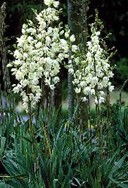 Every garden needs focal points and a few bold plants can fill the need. Focal points draw and direct the eye around the garden and help the visitor appreciate the many textures and colors that make a garden beautiful. The careful placement of a few bold accent plants can create interest and bring excitement into the garden.
Every garden needs focal points and a few bold plants can fill the need. Focal points draw and direct the eye around the garden and help the visitor appreciate the many textures and colors that make a garden beautiful. The careful placement of a few bold accent plants can create interest and bring excitement into the garden.
Here are five herbaceous plants that can be used as focal points in the garden. Careful positioning is especially important when using bold plants because they must attract and lead the eye while not becoming too overpowering. They are most effective when planted with plants that are dissimilar in regard to texture or color so that they stand out and catch the eye.
 Yucca
Yucca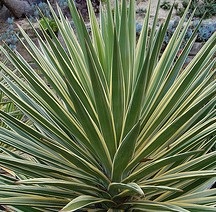
Native to North America, these evergreen shrub-like plants grow in large rosettes of long gray-green-sword-like leaves and produce clusters of whitish bell-shaped flowers on tall stout stems. Several species are suitable for gardens including Y. glauca, Y. filamentosa, Y. gloriosa, and Y. flaccida. Outstanding variegated cultivars are available.
Size: 3-8’ H x 2-4’ W
Bloom Time: Late spring to fall depending on the species
Light: Full sun
Soil: Average, dry to medium moist, well-drained
Hardiness: Zones 4-10 (Y flaccida zones 7-10)
 Euphorbia characias ssp. wulfenii
Euphorbia characias ssp. wulfenii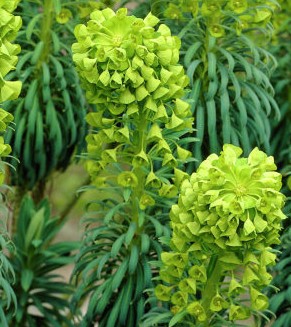
A native of the eastern Mediterranean area, this upright perennial grows rapidly and forms a bushy mound with evergreen leathery blue-green leaves. Large rounded lime-green flower heads are produced in early spring for a striking effect. Long lived, pest and disease free, the plant can be grown in containers and brought indoors in cold climates. Warning: The white milky sap is poisonous and can irritate the skin.
Size: 4-5’ H x 3’ W
Bloom Time: Early spring
Light: Sun to part sun
Soil: Poor to medium, medium moist, well-drained
Hardiness: Zones 8-10
 Canna x generalis
Canna x generalis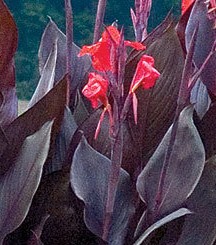
Grown primarily for their handsome foliage, cannas introduce a tropical note to the garden with their large, smooth, banana-like foliage, marked by prominaent veins. The leaves may be green, purple, or variegated with yellow and shades of red to pink. The flowers are produced in terminal spikes and may be red, orange, pink, or yellow. Dwarf cultivars have been produced but the most impact comes from the tall varieties. In cold climates lift and store the bulbs after the first severe frost.
Size: 1.5-9’ H x 1.5-3’ W
Bloom Time: Summer
Light: Full sun
Soil: Fertile, medium moist, well-drained
Hardiness: Zones 8-10
 Mullein (Verbascum phlomoides)
Mullein (Verbascum phlomoides)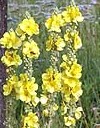
This biennial mullein produces a large rosette of rounded downy grey leaves its first year. And in the second year sends up a branching stem of densely packed bright yellow flowers. Known for its long bloom time lasting many weeks. Plants readily self-seed and the seedlings that result grow taller than ones transplanted into the garden.
Size: 4-6’ H x 30” W
Bloom Time: Summer
Light: Full sun
Soil: Light, dry to medium moist, well-drained
Hardiness: Zones 5-9
 Leopard Plant (Ligularia dentata)
Leopard Plant (Ligularia dentata)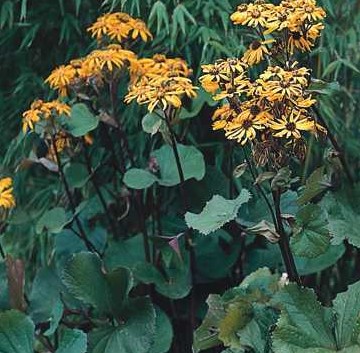
For moist conditions, this perennial from Japan and China, is especially valuable. It forms large clumps of huge, leathery, dark-green kidney-shaped leaves borne on long stalks. Loose clusters of bright orange t0 yellow daisy-like flowers two the three inches across are produced on branched cormbs above the foliage in early summer. The plants are worth growing just for the foliage. ‘Desdemona’ has leaves with dark purple undersides and is more compact than the species.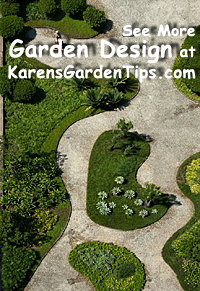
Size: 3-4’ H x 2-3’ W
Bloom Time: June to July
Light: Part to full shade
Soil: Humusy, medium to wet (plant must never dry out)
Hardiness: Zones 3-8